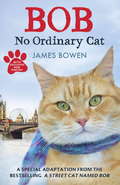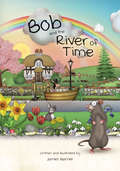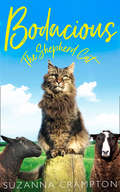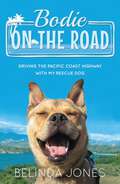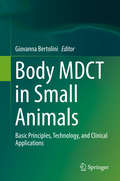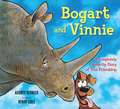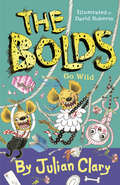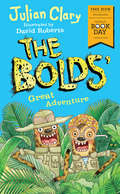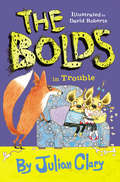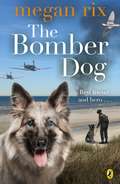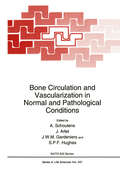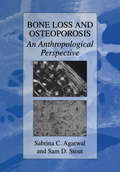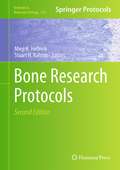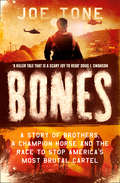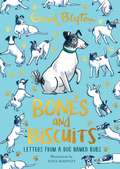- Table View
- List View
Bob: No Ordinary Cat
by James BowenThe phenomenal bestseller A Street Cat Named Bob, featuring best friends James and street cat Bob, now available as a special edition for children aged 11 and above.'We are all given second chances every day of our lives, but we don't usually take them. Then I met Bob.'James Bowen was a homeless musician, busking on the streets of London to survive. But the moment he met an injured stray cat with ginger fur and big green eyes, his life began to change. Together James and Bob the cat faced the world - and won. A purrfectly true 'tail' of love and friendship to make you smile!Please note contains some drug references.
Bob and the River of Time
by James GarnerMeet Bob as he journeys along the magical River Mumbles, which flows through Grumbledown. The river takes Bob on an unexpected, topsy-turvy journey through the seasons, and on his way he sees a host of different creatures and plants. Bob and the River of Time is a fantastical, educational picture book written and illustrated by James Garner. It is a charming, fun short story ideal for entertaining and inspiring children (it's suitable for children aged 3 years and upwards). At the same time, the characters, scenery and changing seasons Bob encounters on his journey will teach children about wildlife and nature. Bob and the River of Time introduces children to the weather, the four seasons and plant and animal life, and also teaches the importance of maintaining a positive outlook when you aren't sure where your journey is taking you. The book is beautifully illustrated with over 100 real-life animal characters, with detailed information about each one at the back of the book. This attention to detail ensures that each time you open the book you'll discover something new and the calming flow of the story will send children to a place of tranquil and inspired imagination. Searching for the many creatures and plants within the book is a great way to focus a child's mind, especially if their mind has a tendency to wander! Bob and the River of Time is a story full of wandering and wondering. Join Bob as he learns one of the most simple, eloquent and powerful lessons life can teach. For children age 3+ years.
Bobcat: Master of Survival
by Kevin HansenBobcat: Master of Survival tells the story of the most adaptable and resilient wild feline in the world. While half the wild cat species worldwide are in danger, the bobcat is thriving, even expanding its range in North America. Why are bobcats flourishing when so many other wild felines are advancing towards extinction? The book explains how scientists apply the latest in wildlife research technology to probe this diminutive predator's habits and behavior. The reader is invited inside the bobcat's world to see how they hunt, kill prey, raise their young, coexist with humans, and deftly navigate the endless obstacles to survival. The bobcat is both the most studied and the most exploited wild feline in the world. Millions have been killed for the fur trade. They were the focus of major controversy in the 1970s that transformed international conservation of wild felines. The book discusses how economics and politics play a far greater role in bobcat management and conservation than does science. Bobcat is the most comprehensive and up-to-date book on the natural history and management of bobcats to appear in 40 years.
Bobcat: Master of Survival
by Kevin HansenBobcat: Master of Survival tells the story of the most adaptable and resilient wild feline in the world. While half the wild cat species worldwide are in danger, the bobcat is thriving, even expanding its range in North America. Why are bobcats flourishing when so many other wild felines are advancing towards extinction? The book explains how scientists apply the latest in wildlife research technology to probe this diminutive predator's habits and behavior. The reader is invited inside the bobcat's world to see how they hunt, kill prey, raise their young, coexist with humans, and deftly navigate the endless obstacles to survival. The bobcat is both the most studied and the most exploited wild feline in the world. Millions have been killed for the fur trade. They were the focus of major controversy in the 1970s that transformed international conservation of wild felines. The book discusses how economics and politics play a far greater role in bobcat management and conservation than does science. Bobcat is the most comprehensive and up-to-date book on the natural history and management of bobcats to appear in 40 years.
Bodacious: The Shepherd Cat
by Suzanna CramptonBODACIOUS: THE SHEPHERD CAT is a heart-warming and charming tale in which Bodacious tells us about life as The Shepherd Cat on Black Sheep Farm.
Bodie on the Road: Driving the Pacific Coast Highway with My Rescue Dog
by Belinda JonesRecently dumped Belinda embarks on a 2,000-mile West Coast road trip with her rescue dog Bodie, taking in spectacular Big Sur, the wilds of Oregon, afternoon tea at Doris Day’s dog-friendly hotel, and a town where a dog was elected mayor. Join Belinda and Bodie on this soul-searching adventure along one of America’s most iconic highways.
Body MDCT in Small Animals: Basic Principles, Technology, and Clinical Applications
by Giovanna BertoliniThis book is an up-to-date, technically detailed yet easy-to-read reference book on current clinical applications of MDCT in small animals. It has been designed to serve as the reference book for all MDCT-users, such as veterinary radiologists, imaging technicians, oncologists, surgeons, and non-radiologist clinicians. Individual chapters on novel clinically important topics include applications in endocrinology, oncology, trauma, and cardiovascular CT, as well as sections on organ-specific pathologies and their CT characteristics. The book will also cover main domains of CT, such as thorax and the trauma imaging. Anatomy, clinical aspects, pathology, and CT signs are integrated to provide the reader with the basis for interpretation of MDCT findings. Many excellent 2D multiplanar and 3D figures illustrating typical CT findings of various conditions will serve as a clinical reference for the reader.
Bogart and Vinnie: A Completely Made-Up Story of True Friendship
by Henry Cole Audrey VernickWhen Vinnie, a crazy-happy dog, gets lost while visiting a nature preserve with his family, he finds comfort in the company of Bogart, a big, lazy rhinoceros. Vinnie loves his new friend, but Bogart would rather just take a nap. A friendship soon blossoms-even if Vinnie's definition of "friendship" is very different from Bogart's-and when word of their unique situation spreads, Bogart and Vinnie are a worldwide sensation! But as soon as their fifteen seconds of fame ends, what's left is a bond even Bogart can't ignore. Pairing picture-book veteran, Henry Cole, with up-and-coming author, Audrey Vernick, this clever spoof of the unendingly popular interspecies animal-friendship story is full of heart and humor.
Bogart and Vinnie: A Completely Made-Up Story of True Friendship
by Audrey VernickWhen Vinnie, a crazy-happy dog, gets lost while visiting a nature preserve with his family, he finds comfort in the company of Bogart, a big, lazy rhinoceros. Vinnie loves his new friend, but Bogart would rather just take a nap. A friendship soon blossoms-even if Vinnie's definition of "friendship" is very different from Bogart's-and when word of their unique situation spreads, Bogart and Vinnie are a worldwide sensation! But as soon as their fifteen seconds of fame ends, what's left is a bond even Bogart can't ignore. Pairing picture-book veteran, Henry Cole, with up-and-coming author, Audrey Vernick, this clever spoof of the unendingly popular interspecies animal-friendship story is full of heart and humor.
The Bolds Go Wild (The Bolds)
by Julian ClaryIt's time for monkey business in this fifth outing for Teddington's wildest family, the Bolds!The Bolds are very surprised to be visited by Fred's mother, Granny Imamu. She's travelled all the way from Africa, and now she's here, she does not approve of what she finds. Hyenas, living as people - whatever next! Granny Imamu starts to stir up mischief with twins Bobby and Betty, encouraging them to get in touch with their beastly side at school. And then the twins' teacher comes to the Bolds with a rather unusual problem: her grown-up son Jeffrey just isn't like other people. He's rather hairy, doesn't much like to talk, and loves to monkey about. If animals can become people, could it happen the other way around . . . ?
The Bolds' Great Adventure: World Book Day 2018 (The Bolds)
by Julian Clary David RobertsFasten your seatbelts - it's a special adventure for World Book Day with Teddington's wildest family! Learn just how our intrepid hyenas managed to get from their African safari park onto the plane and off to their new home in England. It's quite a remarkable, and some would say, unbelievable tale - but there are many laughs along the way!
The Bolds in Trouble (The Bolds #4)
by Julian Clary David RobertsThe Bolds are back for another hilarious tale!This time, Teddington's wildest family have decided to stay at home and keep their heads down - it isn't always easy hiding tails and fur under clothes, and it's important not to raise suspicion amongst their human neighbours. But trouble soon comes skulking when a very sly fox starts making a big nuisance of himself. It's up to the Bolds to try and stop him - but the solution has them foxed...
The Bomber Dog
by Megan RixThe Bomber Dog is a heartwarming story for 9+ readers about a brave puppy who joins the paratroopers during the Second World War and becomes a heroic war dog. Perfect for fans of Michael Morpurgo's War Horse and Lauren St John.GREY is just a puppy when he arrives at the War Dog Training school.NATHAN, his trainer, is a brave young soldier.WOLF is a war dog who's seen it all.Grey and Nathan soon become inseparable. Until the day a parachute jump goes tragically wrong . . .As the Second World War rages, Grey faces his most important mission yet: to find his best friend. With Wolf at his side, he must journey across France and behind enemy lines. His path is fraught with danger. Can he reach Nathan before it's too late?Praise for Megan Rix:'If you love Michael Morpurgo, you will enjoy this' Express 'A moving tale told with warmth, kindliness and lashings of good sense that lovers of Dick King-Smith will especially appreciate' The Times'Every now and then a writer comes along with a unique way of storytelling . . . Meet Megan Rix . . . her novels are deeply moving and will strike a chord with animal lovers.' LoveReadingAbout the author:Megan Rix lives in England with her husband, and their adorable dogs, Traffy and Bella. Also available by Megan Rix:The Great Escape, The Victory Dogs.www.meganrix.com
Bone Circulation and Vascularization in Normal and Pathological Conditions (Nato Science Series A: #247)
by A. Schoutens J. Arlet Jean Wm Gardeniers S P F HughesThe Association Internationale de Recherche sur la Circulation Osseuse, A.R.C.O., was founded in London in December 1989 by a small group of doctors, surgeons and researchers in basic sciences who had been involved for many years in the study of bone circulation and its disorders. They had met several times in Toulouse, during the International Symposia on Bone Circulation held there since 1973 and they wished to carry their contacts further. In founding A.R.C.O., they established as their primary aims the encouragement and furtherance of research, organisation of meetings and promotion of knowledge on the subject. At the present time, the Association has over a hundred members from more than bone tissue twenty countries in Europe, America and Asia. All have the conviction that and its pathology can only be truly known and studied if one has an understanding of its vascular system and the way its circulation functions. This concept, apparently beyond question, has not yet been adopted by all physicians and scientists who are interested in bone. From time to time, one comes across teaching programmes on bone patho logy which make no mention of bone circulation.
Bone Loss and Osteoporosis: An Anthropological Perspective
by Sabrina C. Agarwal and Sam D. StoutWith the growing incidence of fragility fractures in Europe and North America over the last three decades, bone loss and osteoporosis have become active areas of research in skeletal biology. Bone loss is associated with aging in both sexes and is accelerated in women with the onset of menopause. However, bone loss is related to a suite of complex and often synergistically related factors including genetics, pathology, nutrition, mechani cal usage, and lifestyle. It is not surprising that its incidence and severity vary among populations. There has been increasing interest to investigate bone loss and osteoporosis from an anthropological perspective that utilizes a biocultural approach. Biocultural approaches recognize the inter-relationship between biological, cultural, and environmental variables. Anthropological studies also highlight the value of evolutionary and population approaches to the study of bone loss. These approaches are particularly suited to elucidate the multifactorial etiology of bone loss. The idea for this volume came out of a symposium organized by the editors at the 70th annual meeting of The American Association of Physical Anthropologists in Kansas City, Missouri. Many of the symposium participants, along with several additional leading scientists involved in bone and osteoporosis research, are brought together in this volume. Each chapter focuses on a different aspect of bone loss and fragility with a fresh and stimulating perspective.
Bone Research Protocols (Methods in Molecular Biology #816)
by Miep H. Helfrich and Stuart H. RalstonStudies over the past decade have continued to bring tremendous advances to our understanding of bone biology. New pathways have been discovered and expanded our knowledge of the ways in which genes and gene products affect bone cells and thereby bone mass and bone strength. In Bone Research Protocols, Second Edition, expert researchers in the field detail many methods commonly used to study bone biology. Focusing mainly on in vitro methods, this volume gives techniques for isolation, culture and functional analysis of all bone cell types and details a range of imaging methods, including light and ultrastructural microscopy and live cell imaging. Some important in vivo techniques are included, such as analysis of bone resorption and imaging using X rays, fluorescent or luminescent techniques. Methods for study of proteins and nucleic acid are included and methods for analysis of bone composition, measurement of bone strength, and response to mechanical stimulation are described. Written in the highly successful Methods in Molecular Biology™ series format, chapters include introductions to their respective topics, lists of the necessary materials and reagents, step-by-step, readily reproducible laboratory protocols, and key tips on troubleshooting and avoiding known pitfalls. Authoritative and practical, Bone Research Protocols, Second Edition seeks to aid scientists in the bone field to establish new techniques in their laboratories.
Bone Toxicology (Molecular and Integrative Toxicology)
by Susan Y. Smith Aurore Varela Rana SamadfamThe content of this book is intended to provide the toxicologist in drug development in the pharmaceutical and biotechnology industries with a broad understanding of bone and its interactions with other organ systems in safety assessments. The book is divided into three parts. The first part describes our current understanding of bone biology and its primary regulatory pathways. Additional chapters address regulatory and study design considerations for incorporating bone end points in toxicology studies, with special consideration being given to juvenile toxicology studies. This is intended to address recent regulatory requirements to evaluate skeletal development for drugs in development for pediatric populations. The second part of the book describes the principal techniques and methods used in bone research; understanding how these end-points are derived is fundamental to their appropriate application. These first two parts of the book provide the background and the means to develop the concepts in part three which describes bone and its interaction with other organ systems. The unique series of chapters in part three, contributed to by key leaders in their respective fields and in bone research, provides a comprehensive collective work. Although constantly evolving, the crosstalk and interaction of the skeleton with several organ systems is now recognized and well documented, such as for the reproductive system, muscle and kidney, while our understanding of the interaction with other organ systems, such as the immune system and CNS, is in its infancy. Recent work highlights the key role of the skeleton in the regulation of energy metabolism and the impact this has on research in metabolic diseases such as obesity and diabetes. The hope is that this book will enlighten many and encourage more to explore the impact of new compounds on the skeleton in the development of effective and safe drugs.
Bone Tumors in Domestic Animals: Comparative Clinical Pathology
by Leonardo LeonardiThis book comparatively examines the etiopathogenetic, clinical-pathological, diagnostic and therapeutic strategies of the main bone tumors of domestic animals. The book also includes a description of the most significant aspects of macroscopic, microscopic, immunohistochemical, instrumental, diagnostic imaging and molecular biology aspects of spontaneous bone tumors in Veterinary Medicine, with also interspecies comparative aspects, including the human one. Last but not least, the book provides an overview of the new diagnostic and therapeutic frontiers related to the approach to animal bone tumors. The book serves as essential reading for professionals, researchers and students who work or want to tackle three paths in the field of comparative veterinary bone oncology.
Bones: A Champion Horse, A Violent Drug Cartel, And The Race To Save A Sport Under Siege
by Joe ToneTwo brothers live parallel lives on either side of the US–Mexico border. This is the dramatic true story of how their worlds collided in a major criminal conspiracy. A KIRKUS REVIEWS NONFICTION BOOK OF THE YEAR A NEW YORK TIMES EDITOR’S PICK
Bones and Biscuits: Letters from a Dog Named Bobs
by Enid BlytonIt's a dog's life! An adorable book of letters from Bobs the dog, by much-loved author Enid Blyton. The perfect gift for animal-lovers of all ages."Bones and biscuits! If a cheeky bird didn't fly down to my nose and eat a crumb off my left whiskers! Really, people have no manners at all these days!" In this very funny book, Bobs gives us his opinions on everything from fireworks to frogs, cats to Christmas, in his own words. This illustrated collection of his letters takes us through a year in the life of Bobs, the adored pet terrier owned by national treasure Enid Blyton. Written by Enid Blyton every week to entertain young readers in the 1920s-40s, these have never been published together in book form before. The perfect gift for readers of any age, from 7 to 97, who love dogs and funny stories.
Bones, Clones, and Biomes: The History and Geography of Recent Neotropical Mammals
by Bruce D. Patterson and Leonora P. CostaAs explorers and scientists have known for decades, the Neotropics harbor a fantastic array of our planet’s mammalian diversity, from capybaras and capuchins to maned wolves and mouse opossums to sloths and sakis. This biological bounty can be attributed partly to the striking diversity of Neotropical landscapes and climates and partly to a series of continental connections that permitted intermittent faunal exchanges with Africa, Antarctica, Australia, and North America. Thus, to comprehend the development of modern Neotropical mammal faunas requires not only mastery of the Neotropics’ substantial diversity, but also knowledge of mammalian lineages and landscapes dating back to the Mesozoic. Bones, Clones, and Biomes offers just that—an exploration of the development and relationships of the modern mammal fauna through a series of studies that encompass the last 100 million years and both Central and South America. This work serves as a complement to more taxonomically driven works, providing for readers the long geologic and biogeographic contexts that undergird the abundance and diversity of Neotropical mammals. Rather than documenting diversity or distribution, this collection traverses the patterns that the distributions and relationships across mammal species convey, bringing together for the first time geology, paleobiology, systematics, mammalogy, and biogeography. Of critical importance is the book’s utility for current conservation and management programs, part of a rapidly rising conservation paleobiology initiative.
Bones, Clones, and Biomes: The History and Geography of Recent Neotropical Mammals
by Bruce D. Patterson and Leonora P. CostaAs explorers and scientists have known for decades, the Neotropics harbor a fantastic array of our planet’s mammalian diversity, from capybaras and capuchins to maned wolves and mouse opossums to sloths and sakis. This biological bounty can be attributed partly to the striking diversity of Neotropical landscapes and climates and partly to a series of continental connections that permitted intermittent faunal exchanges with Africa, Antarctica, Australia, and North America. Thus, to comprehend the development of modern Neotropical mammal faunas requires not only mastery of the Neotropics’ substantial diversity, but also knowledge of mammalian lineages and landscapes dating back to the Mesozoic. Bones, Clones, and Biomes offers just that—an exploration of the development and relationships of the modern mammal fauna through a series of studies that encompass the last 100 million years and both Central and South America. This work serves as a complement to more taxonomically driven works, providing for readers the long geologic and biogeographic contexts that undergird the abundance and diversity of Neotropical mammals. Rather than documenting diversity or distribution, this collection traverses the patterns that the distributions and relationships across mammal species convey, bringing together for the first time geology, paleobiology, systematics, mammalogy, and biogeography. Of critical importance is the book’s utility for current conservation and management programs, part of a rapidly rising conservation paleobiology initiative.
Bones, Clones, and Biomes: The History and Geography of Recent Neotropical Mammals
by Bruce D. Patterson Leonora P. CostaAs explorers and scientists have known for decades, the Neotropics harbor a fantastic array of our planet’s mammalian diversity, from capybaras and capuchins to maned wolves and mouse opossums to sloths and sakis. This biological bounty can be attributed partly to the striking diversity of Neotropical landscapes and climates and partly to a series of continental connections that permitted intermittent faunal exchanges with Africa, Antarctica, Australia, and North America. Thus, to comprehend the development of modern Neotropical mammal faunas requires not only mastery of the Neotropics’ substantial diversity, but also knowledge of mammalian lineages and landscapes dating back to the Mesozoic. Bones, Clones, and Biomes offers just that—an exploration of the development and relationships of the modern mammal fauna through a series of studies that encompass the last 100 million years and both Central and South America. This work serves as a complement to more taxonomically driven works, providing for readers the long geologic and biogeographic contexts that undergird the abundance and diversity of Neotropical mammals. Rather than documenting diversity or distribution, this collection traverses the patterns that the distributions and relationships across mammal species convey, bringing together for the first time geology, paleobiology, systematics, mammalogy, and biogeography. Of critical importance is the book’s utility for current conservation and management programs, part of a rapidly rising conservation paleobiology initiative.
Bones, Clones, and Biomes: The History and Geography of Recent Neotropical Mammals
by Bruce D. Patterson Leonora P. CostaAs explorers and scientists have known for decades, the Neotropics harbor a fantastic array of our planet’s mammalian diversity, from capybaras and capuchins to maned wolves and mouse opossums to sloths and sakis. This biological bounty can be attributed partly to the striking diversity of Neotropical landscapes and climates and partly to a series of continental connections that permitted intermittent faunal exchanges with Africa, Antarctica, Australia, and North America. Thus, to comprehend the development of modern Neotropical mammal faunas requires not only mastery of the Neotropics’ substantial diversity, but also knowledge of mammalian lineages and landscapes dating back to the Mesozoic. Bones, Clones, and Biomes offers just that—an exploration of the development and relationships of the modern mammal fauna through a series of studies that encompass the last 100 million years and both Central and South America. This work serves as a complement to more taxonomically driven works, providing for readers the long geologic and biogeographic contexts that undergird the abundance and diversity of Neotropical mammals. Rather than documenting diversity or distribution, this collection traverses the patterns that the distributions and relationships across mammal species convey, bringing together for the first time geology, paleobiology, systematics, mammalogy, and biogeography. Of critical importance is the book’s utility for current conservation and management programs, part of a rapidly rising conservation paleobiology initiative.
